Tahrir Square
Tahrir Square (Arabic: ميدان التحرير Mīdān at-Taḥrīr, IPA: [meˈdæːn ettæħˈɾiːɾ], English: Liberation Square), also known as "Martyr Square", is a major public town square in downtown Cairo, Egypt. The square has been the location and focus for political demonstrations in Cairo, most notably those that led to the 2011 Egyptian revolution and the resignation of President Hosni Mubarak.
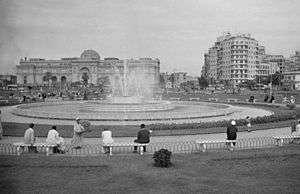
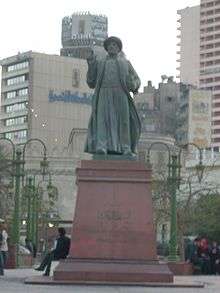
History
The square was originally called "Ismailia Square" (ميدان الأسماعيليّة Mīdān al-Ismā‘īliyyah), after the 19th-century ruler Khedive Ismail, who commissioned the new downtown district's 'Paris on the Nile' design. After the Egyptian Revolution of 1919, the square became widely known as Tahrir (Liberation) Square, but the square was not officially renamed until the Egyptian Revolution of 1952, which changed Egypt from a constitutional monarchy into a republic. The square was a focal point for the Egyptian Revolution of 2011.[1]
Features
.jpg)
At the centre of Tahrir Square is a large and busy traffic circle. On the north-east side is a plaza with a statue of nationalist hero Umar Makram, celebrated for his resistance against Napoleon I's invasion of Egypt, and beyond is the Umar Makram Mosque.[2]
The square is the northern terminus of the historic Qasr al-Ayni Street, the western terminus of Talaat Harb Street, and via Qasr al-Nil Street crossing its southern portion it has direct access to the Qasr al-Nil Bridge crossing the nearby Nile River.
The area around Tahrir Square includes the Egyptian Museum, the Folklore Arts House, the Mogamma government building, the Headquarters of the Arab League building, the Nile Hotel, Kasr El Dobara Evangelical Church and the original downtown campus of the American University in Cairo. The National Democratic Party-NDP headquarters building stood here until it was set on fire during the revolution and demolished in 2015.[3]
The Cairo Metro serves Tahrir Square with the Sadat Station, which is the downtown junction of the system's two lines, linking to Giza, Maadi, Helwan, and other districts and suburbs of Greater Cairo. Its underground access viaducts provide the safest routes for pedestrians crossing the broad roads of the heavily trafficked square.
Public use and demonstrations
Tahrir Square has been the traditional site for numerous major protests and demonstrations over the years, including the 1977 Egyptian Bread Riots, and the March 2003 protest against the War in Iraq.[4]
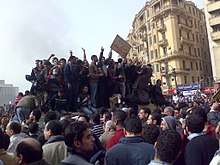
2011 Egyptian Revolution
Tahrir Square was the focal point of the 2011 Egyptian Revolution against former president Hosni Mubarak.[5] Over 50,000 protesters first occupied the square on 25 January, during which the area's wireless services were reported to be impaired.[6] In the following days, Tahrir Square continued to be the primary destination for protests in Cairo.[7] On 29 January, Egyptian fighter aircraft flew low over the people gathered in the square. On 30 January, the seventh day of the protests, PIK BBC and other correspondents reported that the number of demonstrators had grown to at least 100,000,[8] and on 31 January, Al Jazeera correspondents reported that the demonstrations had grown to at least 250,000 people.[9] On 1 February, Al Jazeera reported that more than one million protesters peacefully gathered in the square and adjacent streets.[10] However, such media reports that so many people congregated in Cairo’s largest public square are believed to be exaggerated for political purposes and, according to Stratfor's analysis, the real number of gathered protesters never exceeded 300,000 people.[11][12]
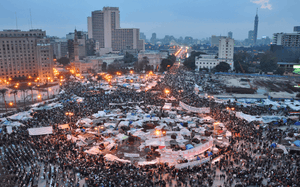
The square became established as a focal point and a symbol for the ongoing Egyptian democracy demonstrations. On 2 February, violence erupted between the pro-Mubarak and pro-democracy demonstrators there, followed by the 3 February 'Friday of Departure' demonstration, one of the named "day of" events centered in the square. Within a week, due to international media coverage, the image and name of Tahrir Square became known worldwide.[13]
A Facebook page called "Tahrir Square" ميدان التحرير was maintained by a rotating staff of twenty during the uprising, particularly to offset the lack of and/or distorted coverage of events and responses in the state-run media outlets.[14]
The 18-day revolt centered in the square provided the Egyptian Armed Forces an opportunity to remove Mubarak from power on Friday, 11 February 2011, when the president officially stepped down from office.[15] The announcement that Mubarak had passed all authority to the Council of the Armed Forces was made by longtime intelligence chief and new vice president Umar Suleiman.[16][17] Tahrir Square erupted in a night-long celebration after the twilight announcement, with shouts such as "Lift your head up high, you're Egyptian", "Everyone who loves Egypt, come and rebuild Egypt", and others.[18] The next day, Egyptian Cairen women and men came to clean up the square, "they came and cleaned up after their revolution," relaying 'projectiles' in the cobblestone paving and removing eighteen days' worth of trash and graffiti.[18]
Post-revolution
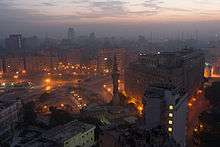
Tahrir Square, with 'democracy anniversary' celebrations and visits from foreign dignitaries, continued to be a symbol of the 2011 Egyptian Revolution.[19][20] British Prime Minister David Cameron, Catherine Ashton, the High Representative for Foreign Affairs and Security Policy of the European Union, Hillary Clinton, Secretary of State of the United States, John Kerry, Chairman of the American Senate Committee on Foreign Relations, Kevin Rudd Foreign Minister of Australia, and American actor Sean Penn visited Tahrir Square after the 2011 Egyptian Revolution.
One of the ships in the planned Freedom Flotilla II, intended to break the Israeli blockade of Gaza, was named Tahrir after the square. Among its passengers was Haaretz reporter Amira Hass. Ultimately, the sailing did not take place.[21]
June 2013 protests and Morsi overthrow
On 29 June 2013, millions of Egyptians converged on Tahrir Square to demonstrate against the Egyptian President Mohamed Morsi, demanding his resignation from office.[22][23] The demonstrators used the slogan "the people want the ouster of the regime," used in the protests that led to the 2011 revolution.[24]
By the 30th, their number had increased[25] and demonstrations were reported to be in progress in 18 locations across Cairo.[26] The demonstration had hundreds of thousands of protesters, although the Egyptian Government claims there were 33 million in the street, this number is highly suspected of since the largest square in Egypt, Tahrir Square, can only hold 2 million people maximum. On 3 July 2013, General Abdul Fatah al-Sisi announced the removal of President Mohamed Morsi and suspended the Egyptian constitution after ongoing public protests. The move was described as a "coup d'état" by supporters of Morsi and/or the Muslim Brotherhood and much of the international media,[27][28][29][30][31], but when combined with the protests, it has instead been described by its supporters, as well as other media outlets, as a revolution.[32][33][34][35]
See also
- Downtown Cairo
- The Square, a documentary film about the square and its role in Egyptian politics
- Graffiti
References
- Vatikiotis, Panayiotis J. (1997). The Middle East: From the End of Empire to the End of the Cold War. Routledge. p. 194.
- "Midan Al-Tahrir, Liberation Square". Tour Egypt.
- Egypt demolishes Mubarak’s party headquarters
- Hiel, Betsy (19 June 2005). "Egyptian reformers taking it to streets". Pittsburgh Tribune-Review.
- "Egypt protests: Anti-Mubarak demonstrators arrested". BBC News. 26 January 2011. Retrieved 26 January 2011.
- "Egyptians report poor communication services on Day of Anger". Almasry Alyoum. 25 January 2011. Retrieved 25 January 2011.
- "Egypt protests: curfew defied in Cairo and other cities". BBC News. 29 January 2011. Retrieved 29 January 2011.
- "Egypt protesters step up pressure on Hosni Mubarak". BBC News. 31 January 2011. Retrieved 31 January 2011.
- "Live blog 31/1 — Egypt protests". Al Jazeera News. 31 January 2011. Retrieved 31 January 2011.
- "Protesters flood Egypt streets". Al Jazeera News. 1 February 2011. Retrieved 1 February 2011.
- "Gauging the Size of the Egyptian Protests". STRATFOR. 31 January 2011. Retrieved 14 June 2011.
- "Update on the Size of Protests in Cairo". STRATFOR. 1 February 2011. Retrieved 14 June 2011.
- "Battle of Tahrir Square". Al Jazeera News. 3 February 2011. Retrieved 3 February 2011.
- Fahim, Kareem; El-Naggar, Mana; Stack, Liam; Ou, Ed (8 February 2011). "Emotions of a Reluctant Hero Galvanize Protesters". The New York Times. Retrieved 9 February 2011.
- "Egypt: The Distance Between Enthusiasm and Reality". STRATFOR. 14 February 2011. Retrieved 14 June 2011.
- Kirkpatrick, David D. and Anthony Shadid from Cairo. Other reporting was contributed by Kareem Fahim, Liam Stack, Mona El-Naggar and Thanassis Cambanis from Cairo, and Alan Cowell from Paris, "Mubarak Steps Down, Ceding Power to Military" ,The New York Times, 11 February 2011.
- "Egypt crisis: President Hosni Mubarak resigns as leader". BBC News. 12 February 2011. Retrieved 21 February 2011.
- "Ahdaf Soueif: Protesters reclaim the spirit of Egypt". BBC News. 13 February 2011. Retrieved 21 February 2011.
- "Thousands attend political rally in central Cairo". BBC News. 18 February 2011. Retrieved 21 February 2011.
- "David Cameron meets locals around Cairo's Tahrir Square". BBC News. 21 February 2011. Retrieved 21 February 2011.
- Hass, Amira (31 January 2011). "Fear and no clean clothing: Amira Hass preparing to sail for Gaza - Haaretz Daily Newspaper | Israel News". Haaretz.com. Retrieved 28 December 2011.
- Hamza Hendawi The Associated Press, Alastair Macdonald (30 July 2013). "Egypt protests: Thousands gather at Tahrir Square to demand Morsi's ouster". thestar.com.
- "Egypt: BBC inside Tahrir Square amid demonstration". BBC News. 30 June 2013.
- "Tahrir Square protesters show President Mursi the 'red card'". Al Arabiya. 30 June 2013.
- "BBC in Egypt: 'People were not expecting this'". BBC News. 30 June 2013.
- Umar Farooq (30 June 2013). "Seeking New Leadership, Millions of Egyptians Take to the Streets". The Atlantic.
- "Coup may give Egypt window to tackle economic problem". Al Arabiya. 5 July 2013. Retrieved 7 July 2013.
- "26 dead, more than 850 wounded as post-coup violence hits Egypt". CNN. 5 July 2013. Retrieved 7 July 2013.
- "Turkey 'strongly condemns' Egypt killings". Al Ahram. 7 July 2013. Retrieved 7 July 2013.
- "Amid post-coup clashes, Egypt's Islamists split". USA Today. 5 July 2013. Retrieved 7 July 2013.
- "Turkey's stance on Egypt coup 'shows its democratic maturity'". Hurriyet Daily News. 7 July 2013. Retrieved 7 July 2013.
- "Revolution in Egypt, again". Deutsche Welle. 4 July 2013. Retrieved 6 July 2013.
- "Mohamed Morsi ousted in Egypt's second revolution in two years". The Guardian. 3 July 2013. Retrieved 6 July 2013.
- "Ahmed Said to Newsmax: Egyptian Uprising 'Big Revolution'". Newsmax. 5 July 2013. Retrieved 6 July 2013.
- "Was Morsi's Ouster a Coup Or New Egyptian Revolution?". Al Monitor. 4 July 2013. Retrieved 6 July 2013.
External links
| Wikimedia Commons has media related to Tahrir Square. |

- BBC: Tahrir Square in wide angle images slideshow
- iPhone Tahrir Square App
- BlackBerry Tahrir Square App
- "Tahrir Documents". University of California, Los Angeles.
Collected from demonstrations in Cairo’s Tahrir Square
2011–present - "University on the Square: Documenting Egypt's 21st century revolution". Rare Books and Special Collections Library, the American University in Cairo.